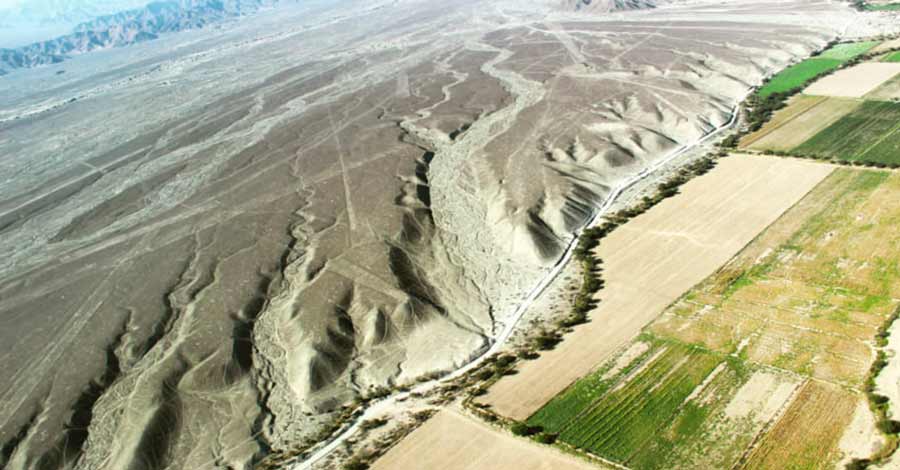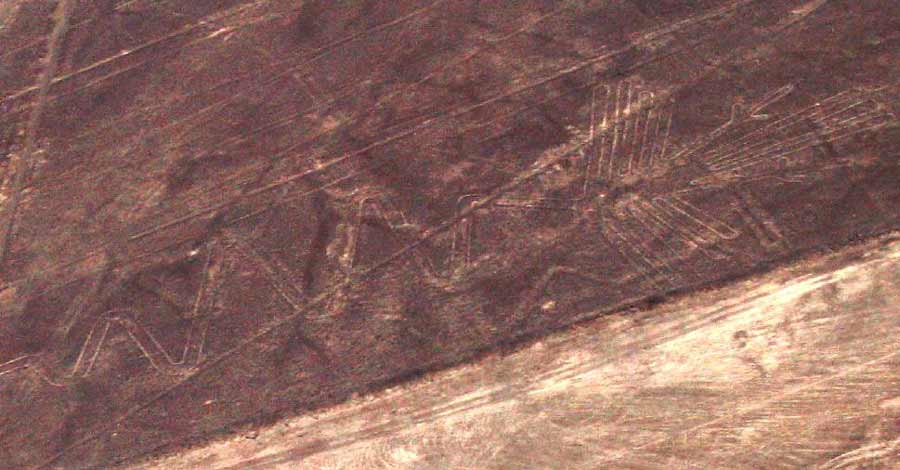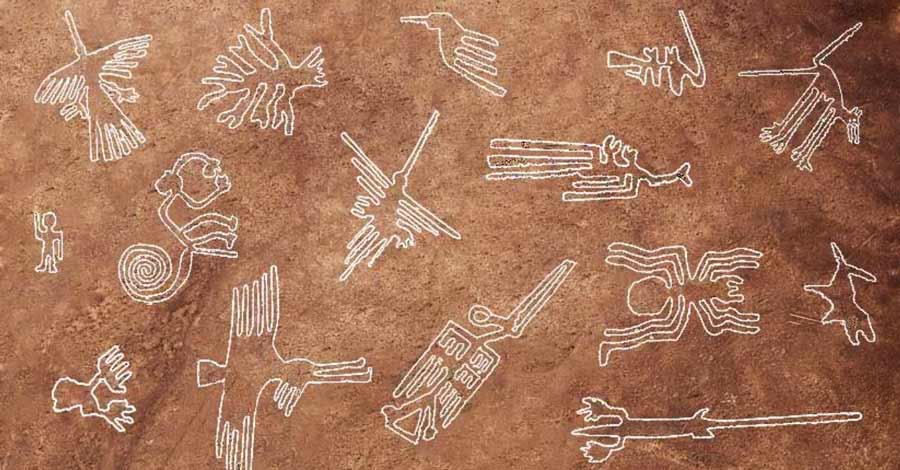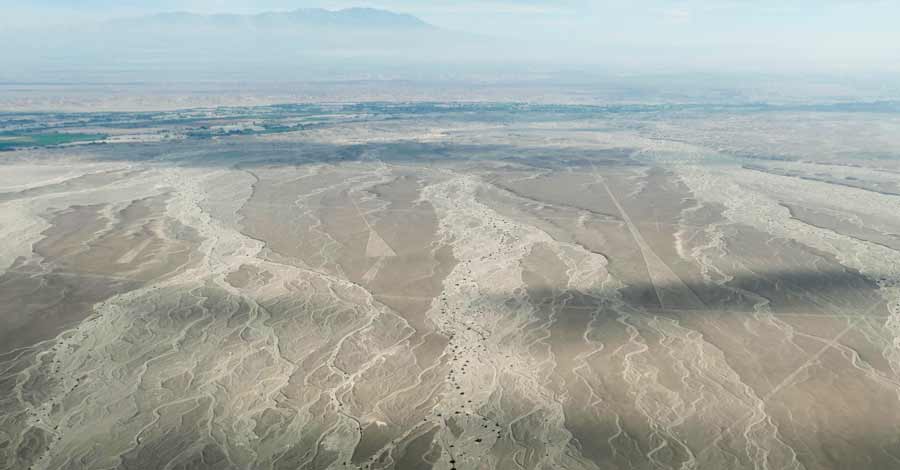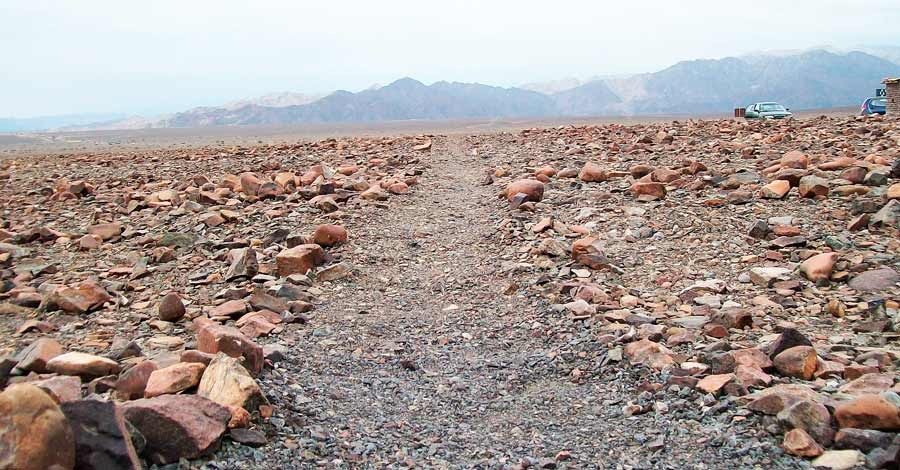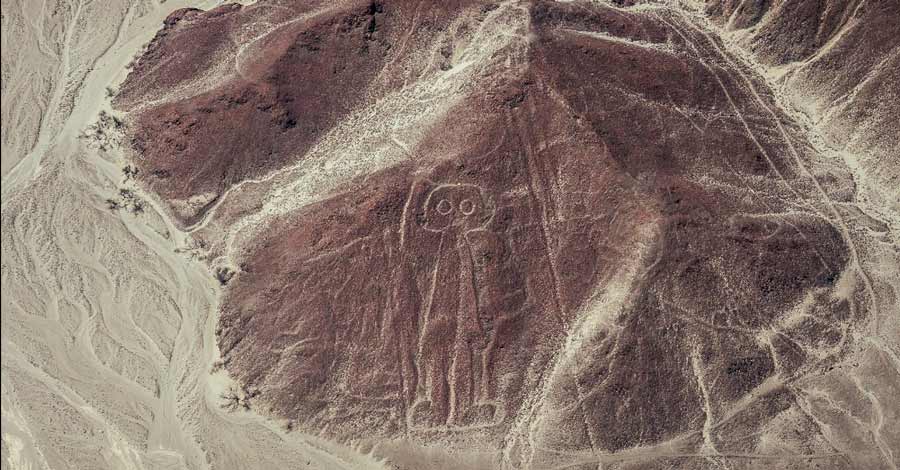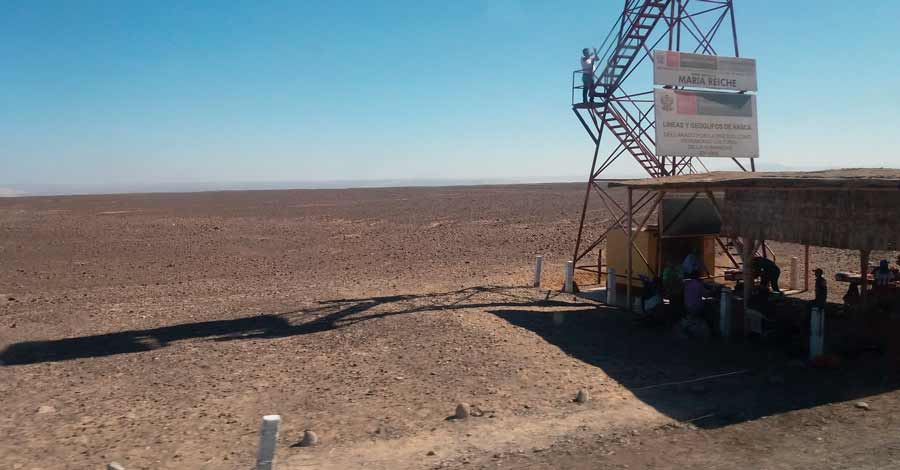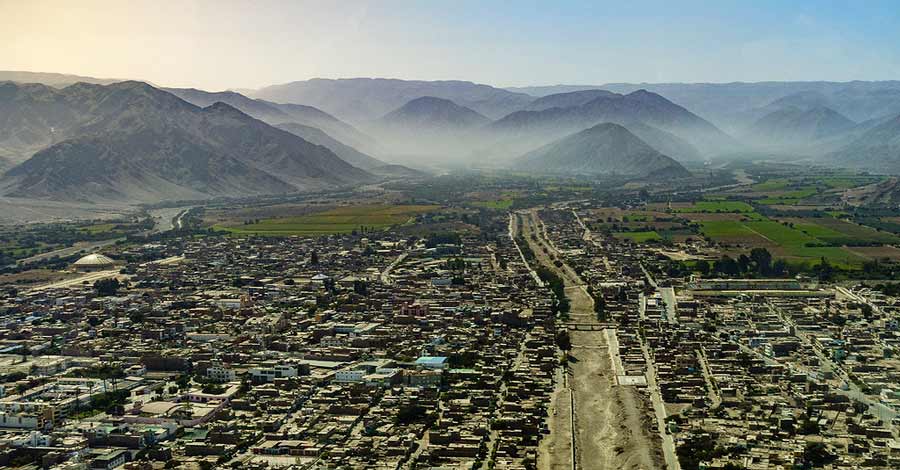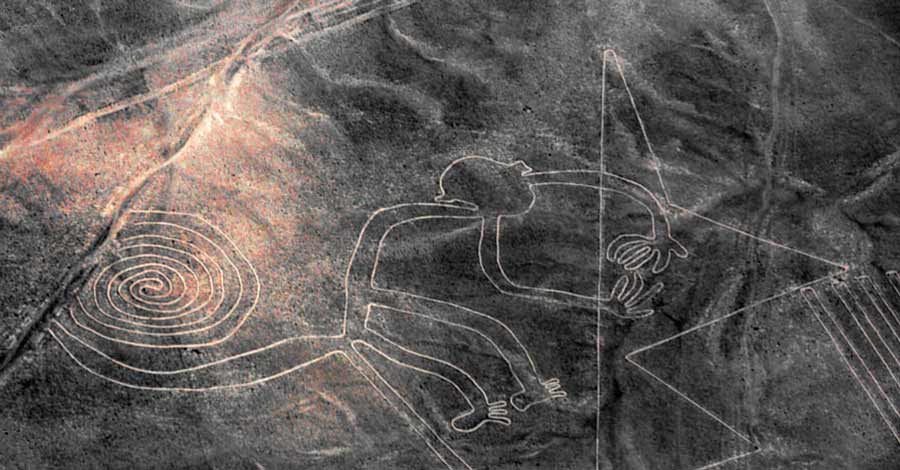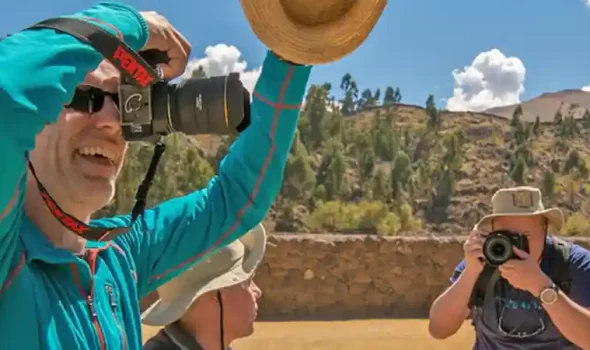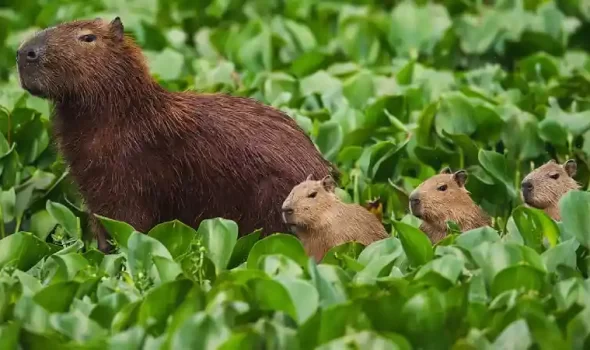When one thinks of the Nazca lines, long ago no one would have thought that this great desert, one of the aridest in the world, would be the scene of one of the world’s most striking and dazzling enigmas. Discover with Auri, some facts, curiosities and secrets of one of the most enigmatic attractions of the planet: the lines of Nazca.
What are the lines of Nazca?
The Nazca Lines are hundreds of enormous pre-Hispanic and pre-Inca geoglyphs that are spread out over an immense desert surface. The Nazca and Palpa desert is home to immense engravings made on its surface.
In other words, the Nazca lines can be compared to a kind of giant canvas in the desert on which an unknown painter would have perfectly represented geometric shapes, complex linear diagrams, animal figures, phytomorphic figures and even highly complex anthropomorphic representations.
Where are Nazca lines?
The Nazca desert is an immense arid expanse trapped between the waters of the Pacific Ocean and the western foothills of the southern Peruvian Andes mountain range. The Nazca Lines are located in the desert of the cities of Nasca and Palpa, in the region of Ica, about 450 kilometers south of Lima (the capital of Peru).
The Nazca lines are located exactly between the provinces of Nazca and Palpa, on the great Nazca desert, most of these figures are located on the plain of Jumana.
How big are the Nazca lines?
There are approximately 800 figures, the largest of which is 300 meters long. They are found in an area of about 450 square kilometers, although many claim that they may be as large as 800 square kilometers. Most of them are geometric designs of animals and plants.
Who made Nazca lines? When were the Nazca lines made?
It is estimated that the Nazca lines were made between 400 B.C. and 1000 A. C. by the Nazca culture. A culture prior to the Inca civilization. So, how old are Nazca lines? The oldest Nazca lines are more than 2800 years old to our present time.
How many Nazca lines are there?
There are about 800 designs in total. Among the best known are the animal figures that total 70 and measure up to 270 meters in length. The giant bird also called flamingo is 300 meters long and 54 meters wide, it is the longest figure of the Nazca pampas.
Some other very famous figures are the hummingbird, the condor, the pelican, the spider, the monkey, the condor and the so-called “Astronaut” (anthropomorphic figure).
What is the significance of the Nazca lines? Nazca lines theories
Today, the Nazca lines continue to generate new interpretations from experts in all disciplines, archaeologists, mathematicians, astronomers, historians, geographers and others. Even specialists from non-academic disciplines, such as parapsychologists and ufologists, have made this Peruvian desert one of their favorite scenarios to test all kinds of theories.
The Nasca lines continue to be a mystery that is not completely solved, the interpretation varies according to the author. Some of the most widespread theories about the function of the Nazca lines are the following:
Astronomical Calendar Theory
The first global interpretation of the lines came from the joint work of Kosok and Maria Reiche in the late 1940s. Both researchers focused their work on studying the relationship of the lines with the rising and setting points of important stars, planets, and constellations to see if the geoglyphs were an instrument for astronomical observation. To this end, they took into account the importance of certain dates in the astronomical calendar (such as the solstices and equinoxes) as well as other essential dates in the Andean agricultural calendar, such as May 6, the date of the beginning of harvesting the crops.
Reiche dedicated almost her entire life to the study of the lines. For her, the creation of the lines would have been inspired by the constellations, by the similarities with them or their shapes, and they could have formed a calendar.
This theory concluded that “the lines are the greatest book of astronomy in the world” and represent “the most fantastic calendar of antiquity”. In other words, the lines would thus be an astronomical calendar that would respond to the need to accurately predict the beginning of the seasons and the harvests.
Route to Cahuachi
This theory, based on a study by Masato Sakai, of Yamagata University in Japan, speaks of the Nazca lines as a route to the ancient city of Cahuachi. At that time, the city of Cahuachi was a religious center noted for its temples and pyramids. According to this theory, the lines would be a path to the city or a series of signs on how to find it.
Spiritual retreat
Clive Ruggles, of the University of Leicester in the United Kingdom, claims that the lines functioned as a spiritual retreat or at least were constructed with that intention.
For Ruggles, the lines would have been walked in single file as a way to connect with the gods, with themselves or with nature. The lines, he asserts, would not have been created to be seen from above, but to be walked.
Water fountains
With a study by the University of Massachusetts, another theory is born: the Nazca lines are actually the sign of subway water sources in the desert.
Stephen B. Mabee, one of the authors of this theory, the springs and seeps associated with the faults provided a more reliable and, in some cases, better quality source of water than rivers. We are testing this scientifically.
Extraterrestrial creation
Erich von Däniken, in which he proclaimed one of the most captivating theories of the century: human evolution was the product of a mutation programmed by extraterrestrial visitors from the remote past.
Däniken extended his theory throughout a series of books that have brought him fame and fortune over the years, but from the beginning the Nazca culture played a central position in his argumentation, which thus affirmed his vision of the mysterious lines of the desert. Near the present small city of Nazca, intelligent foreign beings landed one day in the desert plain. They installed an improvised aerodrome for their spacecraft that had to carry out their operations in the proximity of the Earth. On this ideal terrain they built two runways. The cosmonauts accomplished their mission and returned to their planet of origin. But the pre-Inca tribes who saw how these foreign creatures, who inspired a deep fear in them, worked, had only one wish: that these gods would return!
Consequently, they set about drawing new lines on the plain, as they saw the gods do. But the gods did not appear again…” Therefore the geometric figures of the desert would be a gigantic space airfield where ships from another planet landed and the lines and drawings would be a message from the natives to their visitors from beyond the stars, a plea for them to return.
How were the Nazca lines made?
How were the nazca lines drawn? The Nazca lines were made by a process of subtraction. A much simpler process than is popularly believed. The creators of these lines were engaged in extracting a series of rusty rocks from the ground. The surface of these deserts is composed of a first layer of iron-rich sand and pebbles that oxidizes on contact with air, giving it a dark reddish color.
Underneath, a few centimeters from the surface, there is a more resistant gypsum-rich limestone layer, so the drawings were made by removing the first red layer and leaving the second one exposed, which hardened on contact with the atmosphere and acquired a yellowish tone.
The lack of precipitation and strong winds meant that the drawings remained unaltered for many centuries, in what is an immense stroke of luck for the world’s archaeological heritage.
In other words, the extreme climatic conditions of the terrain make the Nazca desert like a sheet of paper on which the action of man on its surface is practically permanent, unless another human being intervenes to erase it.
It is probable that the figures were designed and executed by means of a system of grids made with wood and ropes to transfer the models to scale.
Nazca Lines, “the astronaut” and other geoglyphs
The owl-man, popularly known as “the astronaut”, is a strange anthropomorphic figure that has become one of the best known of the Nazca Lines. The esoteric theories defend that it is a figure that explains that the geoglyphs were drawn as messages for extraterrestrials. Other theories defend that this anthropomorphic figure actually represents a fisherman.
Among the most striking and popular geoglyphs are the following:
- The hummingbird, which stands out for its harmonic dimensions. Between its two wings there is a distance of about 66 meters.
- The monkey has a spiral-shaped tail and nine fingers, its size is 135 meters.
- The spider is another of the most characteristic figures of Nazca, made with a single continuous line. It is about 46 meters long.
- The giant bird, also called flamingo, measures 300 meters. It has a snake-shaped neck and its beak points directly towards the point where the sun rises in June.
Brief history of the discovery of the Nazca Lines
The first historical data on the existence of the Nazca lines date back to the colonial period, when the Spaniards arrived and noticed the presence of these immense designs. The chronicler Pedro Cieza de Leon mentioned that in the Nazca region there were signs traced on the ground, marks made by the people before the conquest that were visible from the nearby elevations.
In 1586, Luis Monzon (the corregidor of the provinces of Rucanas and Soras) noted that those tracings must have served as roads. But it was not until four centuries later that the true dimension of what had been engraved in the desert floor was appreciated.
In September 1927, Peruvian archaeologist Toribio Mejia Xesspe was working with Julio Cesar Tello touring the alluvial valleys of the southern Peruvian Andes in search of possible sites for future archaeological missions to document pre-Hispanic cultures. Mejia noticed an anomaly located towards the great desert. Observing from a certain height, large lines were visible on the earth’s surface.
After Mejia noticed the same thing as Cieza de Leon almost four hundred years before him, Mejia believed that it was a system of ceques or sacred roads, although he could not explain what they were for.
Who discovered the Nazca lines?
There was a key person in the dissemination of these geoglyphs, Paul Kosok, a character who was interested in the work of hydrology and irrigation systems of pre-Columbian peoples. Kosok made the first overflight of the area in 1939. This changed the perception of these lines forever.
Kosok appreciated figures of all kinds that could only be appreciated in all their magnitude from an airplane, the use of aerial exploration was what opened the eyes of the world to this desert.
How to get to the Nazca lines?
The only way to get to Nazca is by land, by the Panamerican Highway. You can get to Nazca by bus from Lima, Ica, Paracas, Cuzco, Arequipa and some other cities, depending on how you are doing your route through Peru.
The bus companies’ stations are located on the outskirts of the city. The distances in Nazca are very short, so in 20 minutes you can walk to the other side without any problem.
In any case, most of the accommodations have transportation from the station to the hotel included.
Where to stay in Nazca?
The best area to stay in Nazca is around the Plaza de Armas, near the bus station. This is the most convenient place to get around. Despite its small size, Nazca offers plenty of accommodations for all tastes and budgets.
Peru has many amazing places waiting for you, discover the most enigmatic and beautiful places in Peru with us. Working for many years in the travel industry, Auri Travel is pleased to help you with your travel plans to Machu Picchu and various places around Peru, come and enjoy a memorable adventure with us!




